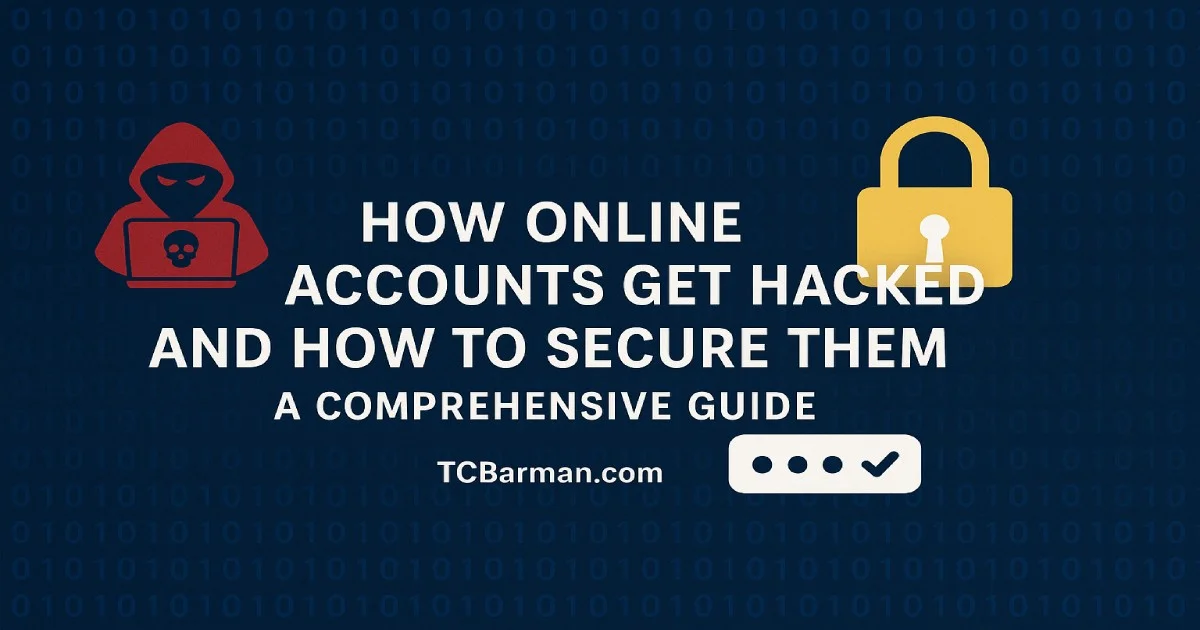We live in the digital age, and we interact with online accounts most days of our lives nowadays. From our social media profiles to email correspondence and internet banking, our personal and professional lives rely ever more on the Internet.
Unfortunately, for the ease with which we can now access these online services, hacking has morphed into a real issue. Here is how hackers get into your accounts, and your money, as your private financial life plays out on the Internet.
In this blog post, we are going to explore a variety of ways in which hackers are able to hack into online accounts in unimaginable ways and, most importantly, what you can do to secure your social media, Instagram, email, internet banking, etc., from hackers.
How Are Online Accounts Hacked?
Knowing how hackers hack is the foundation on which your defenses are built, so let’s first examine how your online accounts are actually compromised. Social engineering, technical holes, and brute force are the most common methods hackers use to gain unauthorized access to accounts. Some of the most common hacking methods include:
Phishing Attacks
One of the most common methods of hacking is phishing. Fake websites or scam emails are sent to victims claiming to represent genuine organizations. Typically, such emails include a link that leads to a replica login page that requests some personal information, such as usernames, passwords, or credit card numbers. The hacker collects this information when it is entered.
Example: An email purportedly from “PayPal” seeking to update your account information. The email includes a link to a fake website to try to steal your account details.
Brute Force Attacks
Brute force attack: Hackers design automated programs that test all possible combinations of usernames and passwords until they hit upon the right one. This method is very effective if your password is weak or common like “123456” or “password123.”
Example: A hacker rents a tool that attempts to guess common passwords like “qwerty” or “admin” with the hope of infiltrating accounts that have weak login protection.
Password Reuse
The same passwords are often used on a number of platforms, including email, social media, and banking, among others. Hackers know this and try to use information obtained in one breach to log into accounts at other sites. If you recycled a password from a service that was hacked, you are potentially at risk of having all of your accounts infiltrated.
Example: If your LinkedIn password leaked in a data breach, attackers might then try to use the same password to break into your Gmail, Facebook, or other accounts.
Keylogging Software
Keyloggers are types of malware that can capture and record the keystrokes on a device without the user's knowledge. Once in place, keyloggers can record everything you type, including your passwords, and then send that data back to the hacker. This malware gets installed on your system using deceitful email attachments, counterfeit software applications, or infected web pages.
Illustration: You downloaded a file from an unknown sender, and it gets a keylogger that saves a log of everything you do.
Man-in-the-Middle (MitM) Attacks
Through a man-in-the-middle attack, hackers siphon off communication between two parties, frequently across open Wi-Fi networks. This would allow the hacker to access the login page of one of your online accounts and then get hold of your login information and more.
Example: Checking your email on public Wi-Fi in a coffee shop and sending your login information unencrypted over the unsecured network, where an attacker is eavesdropping.
Exploiting Security Vulnerabilities
Hackers also search for weaknesses in websites or services. If a platform has unanswered security holes, hackers can use those flaws to breach user accounts. That’s why it’s so important for websites to update and patch their software regularly.
Example: A bug in the security code of a well-known social media platform enables hackers to gain unauthorized access to accounts.
How to Make Your Online Accounts More Secure
Now that you know how online accounts become compromised, you've learned how to defend yourself against these threats. Here are concrete steps you can take to protect your online accounts:
1. Use Strong, Unique Passwords
A strong password is your first line of defense against hackers. Steer clear of simplistic passwords, such as your name or birth date, and don’t opt for “123456.” I put that word in quotes because so many people choose ridiculous passwords. Instead, use long, cryptographically random passwords containing mixed case, alpha, numeric, and symbols.
Best Practices for Passwords:
-
Use at least 12 characters.
-
Don’t pick something really obvious or popular!
-
Use a combination of numbers, characters, and letters.
-
Do have a different password for every account.
Example: A good password, such as “T@l7&cJ#r2W5!8D” is significantly more challenging to break than “password123.”
2. Turn On Two-Factor Authentication (2FA)
This is not the time to get lazy about security! Two-factor authentication provides an additional layer of security by prompting you to enter not only your password, but also a second factor of identification. This might be a code sent to your phone via a text message or an app such as Google Authenticator or Authy.
How to Enable 2FA:
-
Visit the security settings of all your online accounts (email, social media, banking, etc.).
-
Turn on two-factor authentication, and follow the instructions to set it up.
The idea is that if your password is cracked/stolen, your account is still safe.
3. Try Not to Use Public Wi-Fi for Sensitive Transactions
Public Wi-Fi is commonly insecure and vulnerable to hacking. Never check your email, online bank account, or account information when you're connected to public Wi-Fi. Only use public Wi-Fi if you absolutely have to, and then use a VPN (Virtual Private Network) to make your connection secure.
4. Be Wary of Phishing Scams
Phishing is still the most popular method for hackers to steal your credentials from you. Be wary of unsolicited emails or requests for personal information. Look for clues in the message, and be cautious about clicking on links or downloading attachments.
How to Spot a Phishing Email:
-
Check addresses from unknown or odd email addresses.
-
Look for typos and grammatical errors.
-
Be wary if the email urges you to do something immediately, such as clicking on a link.
5. Update Your Devices and Software
Regular updates push out patches to fix security vulnerabilities in software that may not have yet been addressed. Check for software updates on your operating system, web browsers, and apps to prevent any possible exploits.
How to Stay Updated:
-
Enable auto-update on your device.
-
Make sure you apply updates when they are released.
6. Use Antivirus Software
With a trusted antivirus program installed on your device, you can detect and remove harmful software such as keyloggers or malware that could compromise your accounts. Frequently check your devices for threats and update the software.
7. Keep an Eye on Your Accounts
Scan your accounts often for unusual activity. It is now common for most social media networks and banks to send alerts when you attempt to log in from a new device or location. Create alerts to monitor for abnormal behavior.
How to Monitor Accounts:
-
Activate notifications for logging into your account.
-
Check your account activity occasionally.
-
Utilize resources such as credit monitoring to keep an eye out for suspicious activities.
8. Secure Your Email Account
Your email account is typically the way to reset passwords for other accounts. Have you secured your email with a strong password and 2FA? Your email is not a defacto backup for weak passwords on other accounts.
9. Watch Out for Social Engineering
Hackers rely a lot on what is known as social engineering, pretending to be a colleague or a friend, and getting you to tell them something sensitive. If the email is unexpected or you think it looks suspicious, always confirm the person asking for personal information is who they say they are.
10. Use Secure Websites
When shopping or anytime you have to put in personal information, make sure the site you are using is secure. Look for “https” in the URL and the padlock symbol next to the address bar. If you don’t see these indicators, never enter personal information on the site.
Conclusion
Your online account is a hacker’s target, and keeping it secure should be at the top of your mind. By knowing how hackers operate and taking preventive measures to safeguard your accounts, you can minimize your chances of becoming a victim of cybercrime.
Just remember, the best way to stay safe online is to be vigilant about your personal data and take steps now to protect it. Strong password use, two-factor authentication adoption, no click-through on phishing, and keeping your computer locked down are all critically important to managing your online identity. Stay informed, stay safe, and have a more secure online experience!

